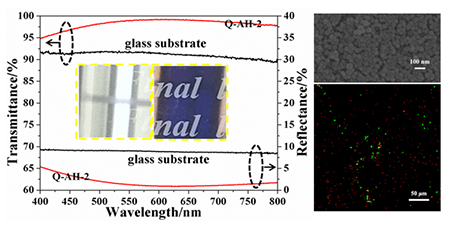| [1] Yao, L.; He, J. Prog. Mater. Sci. 2014, 61, 94.
[2] Xu, L.; He, J. J. Mater. Chem. C 2013, 1, 4655.
[3] Li, T.; He, J. J. Mater. Chem. C 2016, 4, 5342.
[4] Zhang, J.; Yu, J. Chin. J. Chem. 2017, 36, 51.
[5] Sun, H.; He, Q.; Yin, S.; Xu, K. Chin. J. Chem. 2017, 35, 1627.
[6] Raut, H. K.; Ganesh, V. A.; Nair, A. S.; Ramakrishna, S. Energy Environ. Sci. 2011, 4, 3779.
[7] Moghal, J.; Kobler, J.; Sauer, J.; Best, J.; Gardener, M.; Watt, A. A.; Wakefield, G. ACS Appl. Mater. Interfaces 2012, 4, 854.
[8] Yao, L.; He, J. J. Mater. Chem. A 2014, 2, 6994.
[9] Tao, C.; Yan, H.; Yuan, X.; Yin, Q.; Zhu, J.; Ni, W.; Yan, L.; Zhang, L. Colloids Surf., A 2016, 509, 307.
[10] Xu, L.; Geng, Z.; He, J.; Zhou, G. ACS Appl. Mater. Interfaces 2014, 6(12), 9029.
[11] Zhang, J.; Lan, P.; Li, J.; Xu, H.; Wang, Q.; Zhang, X.; Zheng, L.; Lu, Y.; Dai, N.; Song, W. J. Sol-Gel Sci. Technol. 2014, 71, 267.
[12] Cloutier, M.; Mantovani, D.; Rosei, F. Trends Biotechnol. 2015, 33, 637.
[13] Kiedrowski, L. M.; Perisetti, A.; Loock, M. H.; Khaitsa, M. L.; Guerrero, D. M. Am. J. Infect. Control 2013, 41, 1136.
[14] Wang, X.; Shi, L.; Zhang, J.; Cheng, J.; Wang, X. RSC Adv. 2017, 7, 31502.
[15] Shao, H.; Meng, W.-D.; Qing, F.-L. J. Fluorine Chem. 2004, 125, 721.
[16] Liu, C. X.; Zhang, D. R.; He, Y.; Zhao, X. S.; Bai, R. J. Membr. Sci. 2010, 346, 121.
[17] Li, L.; Chi, X.; Yan, J.; Zhao, Z. Chin. J. Org. Chem. 2018, 38, 955. (李令东, 迟晓芳, 闫佳威, 赵梓含, 有机化学, 2018, 38, 955.)
[18] Asri, L. A. T. W.; Crismaru, M.; Roest, S.; Chen, Y.; Ivashenko, O.; Rudolf, P.; Tiller, J. C.; van der Mei, H. C.; Loontjens, T. J. A.; Busscher, H. J. Adv. Funct. Mater. 2014, 24, 346.
[19] Gottenbosa, B.; Mei, H. C. V.; Klatterb, F.; Nieuwenhuisb, P.; Busscher, H. J. Biomaterials 2002, 23, 1417.
[20] Nishihara, T.; Okamoto, T.; Nishiyama, N. J. Appl. Microbiol. 2000, 88, 641.
[21] Laopaiboon, L.; Hall, S. J.; Smith, R. N. J. Appl. Microbiol. 2002, 93, 1051.
[22] Kim, S.; Jung, U. T.; Kim, S. K.; Lee, J. H.; Choi, H. S.; Kim, C. S.; Jeong, M. Y. ACS Appl. Mater. Interfaces 2015, 7, 326.
[23] Zhou, H.; Li, J.; Bao, S.; Li, J.; Liu, X.; Jin, P. Appl. Surf. Sci. 2016, 363, 532.
[24] Wang, K.; He, J. ACS Appl. Mater. Interfaces 2018, 10, 11189.
[25] Zhang, Q.; Liu, H.; Zhan, X.; Chen, F.; Yan, J.; Tang, H. RSC Adv. 2015, 5, 77508.
[26] Andreu, N.; Flahaut, D.; Dedryvere, R.; Minvielle, M.; Martinez, H.; Gonbeau, D. ACS Appl. Mater. Interfaces 2015, 7, 6629.
[27] Zhang, X.; Lan, P.; Lu, Y.; Li, J.; Xu, H.; Zhang, J.; Lee, Y.; Rhee, J. Y.; Choy, K. L.; Song, W. ACS Appl. Mater. Interfaces 2014, 6, 1415.
[28] Zhang, X.; He, J. Chem. Commun. (Camb) 2015, 51, 12661.
[29] Knetsch, M. L. W.; Koole, L. H. Polymer 2011, 3, 340.
[30] Majumdar, P.; Lee, E.; Gubbins, N.; Christianson, D. A.; Stafslien, S. J.; Daniels, J.; VanderWal, L.; Bahr, J.; Chisholm, B. J. J. Comb. Chem. 2009, 11, 1115.
[31] Kugler, R.; Bouloussa, O.; Rondelez, F. Microbiology 2005, 151, 1341. |
